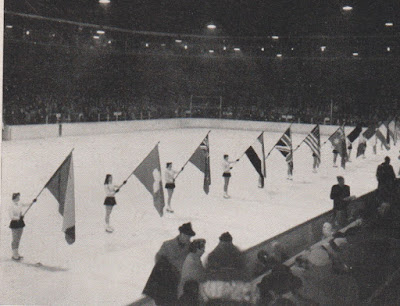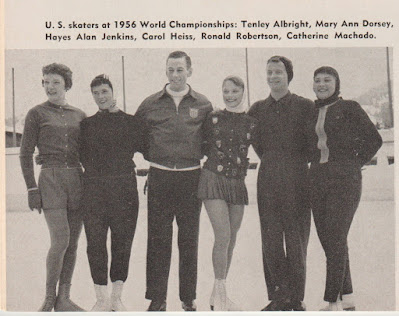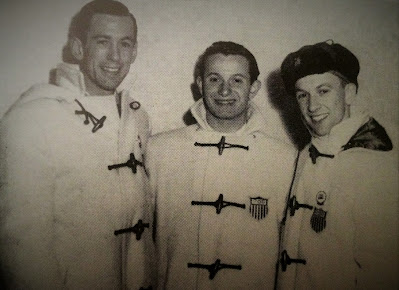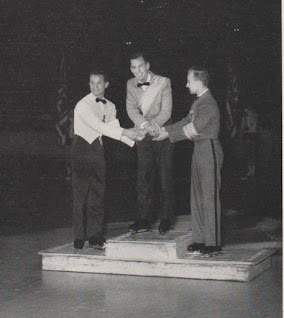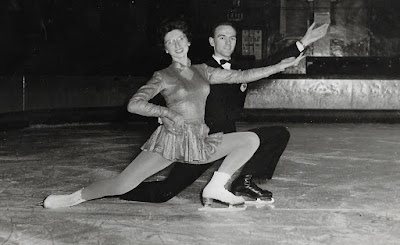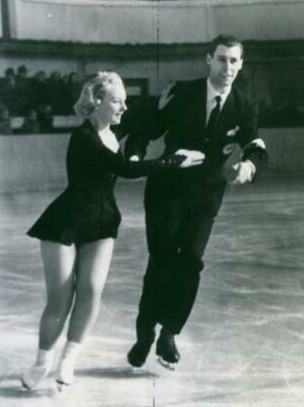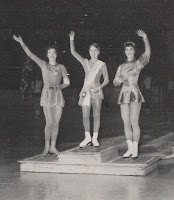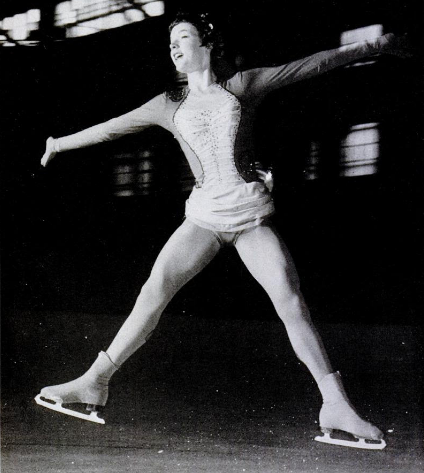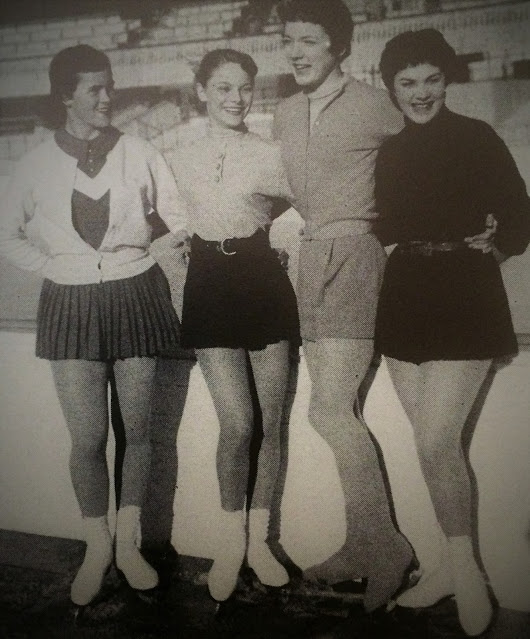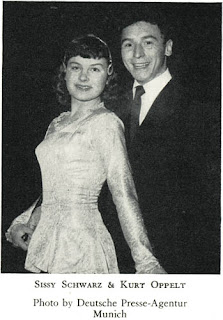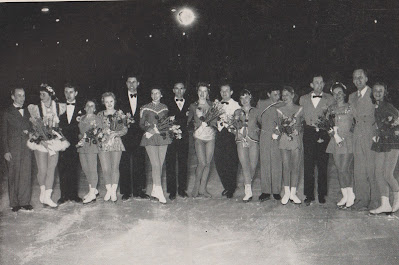It was twenty degrees below zero when the Canadian contingent arrived in West Germany without their team leader Ralph McCreath only to find the hotel where they were supposed to be booked had no record of their reservations. Carol Heiss arrived around the same time only to find that she too had no reservation. It took two days to sort out the whole mess, and when McCreath finally arrived via Rome he arranged for Heiss and her mother to have private rooms in the same hotel as the Canadian team. In turn, Pierre Brunet (Carol's coach) looked after Frances Dafoe and Norris Bowden, whose coach Sheldon Galbraith had been called back to the Toronto Skating Club to help with the club's annual carnival. Skaters like America's Mary Ann Dorsey and Austria's Ilse Musyi, who hadn't competed at the Olympics but had travelled with their country's respective Olympic teams, benefited from no missed practice time due to travel and the experience of practicing with more experienced skaters on Olympic ice.
Photo courtesy "Skating" magazine.
In West Germany, practice conditions were less than ideal for all skaters. Dafoe recalled, "At Garmisch we trained in 18 degrees below... I developed hypothermia and couldn't control my shaking. Pierre Brunet noticed what was happening and carried me into a warm room." Throw on a sweater and warm up and join me as I take an in-depth look at how each of the respective competitions in Garmisch-Partenkirchen ultimately played out.
THE MEN'S COMPETITION
As in Cortina d'Ampezzo, the men's competition was a three-way fight between Hayes Alan Jenkins, his younger brother David and Ronnie Robertson. And as in Cortina d'Ampezzo, Hayes all but assured himself victory by decisively winning the school figures with first place ordinals from eight of the nine judges.
The free skate was a completely different story. All nine judges gave the edge to Robertson, but it wasn't enough for him to unseat the newly crowned Olympic Gold Medallist. David Jenkins was almost unanimously third, with only the Czechoslovakian judge daring to place rising star Karol Divín ahead of him. Canadian Champion Charles Snelling improved upon his eighth place finish at the Olympics by placing a strong fourth ahead of Great Britain's Michael Booker.
While Hayes Jenkins had fond memories of standing on the podium with his brother and sharing a moment in the spotlight with his future wife Carol Heiss, David Jenkins' memories of this event weren't as glowing. In his April 2011 interview on The Manleywoman SkateCast, he recalled, "It was five below, and my brother said I should get my skates sharpened, and I was stubborn and I resisted. I fell on both the triples and twice trying to get back up. I really had warmed up probably than I better had, and I thought I was on top of the world, and the crowd was getting all excited and I thought that was just great. And I think I totally stopped thinking. The next year I was world champion, and I never fell again in competition. After that one, my coach insisted that I fall in warmup whether I needed to or not, just so that he’d have some idea that I was still keeping my mind working."
THE ICE DANCE COMPETITION
With the retirement of four time World Champions Jean Westwood and Lawrence Demmy and 1955 World Bronze Medallists Barbara Radford and Raymond Lockwood, the path to gold was clear for twenty two year old Pamela Weight and her nineteen year old partner Paul Thomas. Although the young team coached by Len Liggett had only been skating together for just over a year, they had already won the silver medal behind Westwood and Demmy at the 1955 World Championships in Vienna and the British senior dance title in November 1955 in Nottingham. Unlike Westwood and Demmy, they had no long term aspirations. She planned to marry; he to move to Canada. Garmisch-Partenkirchen was their last hurrah... and a hurrah it was! Weight and Thomas dominated all four compulsory dances - the Foxtrot, Paso Doble, Tango and Westminster Waltz - and the free dance and were placed first on every judge's scorecards in every phase of the competition.
THE MEN'S COMPETITION
A triple threat from America: Hayes Alan Jenkins, Ronnie Robertson and David Jenkins
As in Cortina d'Ampezzo, the men's competition was a three-way fight between Hayes Alan Jenkins, his younger brother David and Ronnie Robertson. And as in Cortina d'Ampezzo, Hayes all but assured himself victory by decisively winning the school figures with first place ordinals from eight of the nine judges.
Left: Men's medallists in 1956. Right: German press clipping of Hayes Alan Jenkins. Photo courtesy Julia C. Schulze.
The free skate was a completely different story. All nine judges gave the edge to Robertson, but it wasn't enough for him to unseat the newly crowned Olympic Gold Medallist. David Jenkins was almost unanimously third, with only the Czechoslovakian judge daring to place rising star Karol Divín ahead of him. Canadian Champion Charles Snelling improved upon his eighth place finish at the Olympics by placing a strong fourth ahead of Great Britain's Michael Booker.
While Hayes Jenkins had fond memories of standing on the podium with his brother and sharing a moment in the spotlight with his future wife Carol Heiss, David Jenkins' memories of this event weren't as glowing. In his April 2011 interview on The Manleywoman SkateCast, he recalled, "It was five below, and my brother said I should get my skates sharpened, and I was stubborn and I resisted. I fell on both the triples and twice trying to get back up. I really had warmed up probably than I better had, and I thought I was on top of the world, and the crowd was getting all excited and I thought that was just great. And I think I totally stopped thinking. The next year I was world champion, and I never fell again in competition. After that one, my coach insisted that I fall in warmup whether I needed to or not, just so that he’d have some idea that I was still keeping my mind working."
THE ICE DANCE COMPETITION
Pamela Weight and Paul Thomas. Photo courtesy "Ice & Roller Skate" magazine.
With the retirement of four time World Champions Jean Westwood and Lawrence Demmy and 1955 World Bronze Medallists Barbara Radford and Raymond Lockwood, the path to gold was clear for twenty two year old Pamela Weight and her nineteen year old partner Paul Thomas. Although the young team coached by Len Liggett had only been skating together for just over a year, they had already won the silver medal behind Westwood and Demmy at the 1955 World Championships in Vienna and the British senior dance title in November 1955 in Nottingham. Unlike Westwood and Demmy, they had no long term aspirations. She planned to marry; he to move to Canada. Garmisch-Partenkirchen was their last hurrah... and a hurrah it was! Weight and Thomas dominated all four compulsory dances - the Foxtrot, Paso Doble, Tango and Westminster Waltz - and the free dance and were placed first on every judge's scorecards in every phase of the competition.
June Markham and Courtney Jones
The British Silver and Bronze Medallists June Markham and Courtney Jones and Barbara Thompson and Gerard Rigby became World Silver and Bronze Medallists in an equally convincing fashion. That said, each of the teams ranked fourth through sixth - Americans Joan Zamboni and Roland Junso (who fell in the free dance) and Carmel and Edward Bodel and France's Fanny Besson and Jean-Paul Guhel - earned ordinals in the top three. Canada's sole entry, young Lindis and Jeffery Johnston, placed ninth of the seventeen teams who competed. The Italian team who placed twelfth, Bona Giammona and Giancarlo Sioli, had ordinals ranging from sixth to fifteenth.
BBC broadcast one hour of free dancing to skating lovers back come in Jolly Ol' England. In her book "Figure Skating History: The Evolution Of Dance On The Ice", Lynn Copley-Grave recalled, "TV commentator Max Robertson repeated publicly a statement by a well-known judge that Weight/Thomas were the best ice dance team ever produced in Great Britain. Jean Westwood refuted the statement in a letter to 'Skating World', reminding readers that she and Lawrence beat them on several occasions." Although Westwood and Demmy certainly had the more distinguished career, Weight and Thomas earned the Vandervell Trophy for their winning performance in Garmisch-Partenkirchen.
THE WOMEN'S COMPETITION
With her terminally ill mother in attendance, Carol Heiss did the unthinkable in the school figures, edging twenty year old Olympic Gold Medallist Tenley Albright five judges to four. Snow fell steadily as the friendly rivals took to the ice to settle the score in the free skate. Tenley skated brilliantly but Heiss only expanded her lead with her performance to Jean Martinon's "If I Were King", earning 5.9's across the board and the first place ordinals of seven of the nine judges. The result ended up five judges to four in Heiss' favour.
"Time" magazine raved that Heiss' "near-flawless execution brought the chilled crowd to its feet. Even one of the judges broke into spontaneous applause". The February, 19, 1956 issue of "The Victoria Advocate" noted that "the tiny blonde skated flawlessly, and her performance feature double Axels, double flips and loops." Heiss celebrated the victory with her mother, grandparents and coach Pierre Brunet. In her December 2012 interview on The Manleywoman SkateCast, Heiss recalled, "That was the world championship where I had worked very hard to get the double Axel. I didn’t quite have it at the Olympics - it was there but I just barely did it, it was one of those low ones. At Worlds I had more confidence, I put two in the program and landed both of them. And I’m convinced it was those clean double Axels that gave me an edge over Tenley."
Austria's Ingrid Wendl received third place ordinals from five judges to Yvonne Sugden and Catherine Machado's two apiece to take the bronze. The lone Canadian entry, Ann Johnston, placed a strong ninth of the twenty nine entries.
A young Sjoukje Dijkstra, competing in her second World Championships, almost didn't make it to the event. In her April 2014 interview on The Manleywoman SkateCast, she recalled, "After the Olympics, we went back to Davos and I got very sick. I had laryngitis... My parents weren't there. I tried everything, penicillin... So from there, I went from my bed to Garmisch. I was so determined that I wanted to compete. I didn't do my best. That was hard, because you know you can do better."
Dijkstra placed sixteenth. Four years later, she would stand on the podium with Heiss at the Winter Olympic Games in Squaw Valley.
THE PAIRS COMPETITION
More than a few people felt that Canada's Frances Dafoe and Norris Bowden had been robbed of a gold medal at the 1956 Winter Olympic Games. They had narrowly lost by one point and two places to Austrians Sissy Schwarz and Kurt Oppelt and delivered one of the finest pairs skating performances the world had ever seen. The World Championships in Garmisch-Partenkirchen were their chance to settle the score and before the event even began, the writing seemed like it was on the wall. Dafoe and Bowden had been told there would be seven judges - three on one side, three on another and a neutral judge from Switzerland. When the judges trotted out, there were suddenly nine. Dafoe and Bowden skated even more brilliantly than they did in Italy, but in the end, five judges (West Germany, Italy, Austria, Czechoslovakia, America) voted for Schwarz and Oppelt and four (Australia, Canada, Great Britain, Switzerland) opted for Dafoe and Bowden. The Austrian judge placed the Canadians third behind bronze medallists Marika Kilius and Franz Ningel and the Canadian judge put Schwarz and Oppelt third behind Americans Carole Ann Ormaca and Robin Greiner, who finished fourth. Placing fifth in only their second trip to the World Championships were Barbara Wagner and Bob Paul.
Dafoe and Bowden's loss sparked an uproar of international proportions which took several years and ISU Council action to repair. Even the West German press decried the result of the event. "The Munich Abendzeitung" proclaimed, "Frances Dafoe and Norris Bowden were the true world champions of the evening... The whole arena was thrilled with excitement, and the spectators roared their delight. They were certain they were watching the world champions... This time Schwarz and Oppelt were nowhere near the precise performance of the Canadians. But not only the Austrian judge was responsible for this regrettable lapse of human objectivity. The Czechoslovak and Italian judges also obviously marked [Dafoe and Bowden] down... Schwarz and Oppelt certainly had good content with lots of pleasant moves, but the exhibition was not as clean as in Cortina, or as sovereign. They were out of balance in spins and the flow from one movement to another was imperfect. There was no ecstatic enjoyment in watching them, but their marks were very high. The Austrian judge gave 5.8 twice, while later he gave the Canadians 5.5 which provoked booing from the crowd." The "Garmisch-Partenkirchen Tagblatt" agreed that the Canadians "deserved to win first place without a doubt."
With little support from the CFSA and their coach not present, Dafoe and Bowden were left to deal with the controversy alone. Schwarz and Oppelt's coach Arnold Gerschwiler came to them after the event and said, "I am here to shake the hands of the true champions" but despite outraged protests to the ISU from coaches who called the event blatantly fixed, the suspect results of this competition remained as is.
At the closing banquet of the event, a speaker alluded to the fact the wrong skaters had won the gold medals in the pairs event. The entire Austrian team rose and walked out in a huff. One year later, the ISU handed three Austrian judges lifetime suspensions.
Skate Guard is a blog dedicated to preserving the rich, colourful and fascinating history of figure skating. Over ten years, the blog has featured over a thousand free articles covering all aspects of the sport's history, as well as four compelling in-depth features. To read the latest articles, follow the blog on Facebook, Twitter, Pinterest and YouTube. If you enjoy Skate Guard, please show your support for this archive by ordering a copy of figure skating reference books "The Almanac of Canadian Figure Skating", "Technical Merit: A History of Figure Skating Jumps" and "A Bibliography of Figure Skating": https://skateguard1.blogspot.com/p/buy-book.html.
BBC broadcast one hour of free dancing to skating lovers back come in Jolly Ol' England. In her book "Figure Skating History: The Evolution Of Dance On The Ice", Lynn Copley-Grave recalled, "TV commentator Max Robertson repeated publicly a statement by a well-known judge that Weight/Thomas were the best ice dance team ever produced in Great Britain. Jean Westwood refuted the statement in a letter to 'Skating World', reminding readers that she and Lawrence beat them on several occasions." Although Westwood and Demmy certainly had the more distinguished career, Weight and Thomas earned the Vandervell Trophy for their winning performance in Garmisch-Partenkirchen.
THE WOMEN'S COMPETITION
Women's medallists in 1956
Tenley Albright
"Time" magazine raved that Heiss' "near-flawless execution brought the chilled crowd to its feet. Even one of the judges broke into spontaneous applause". The February, 19, 1956 issue of "The Victoria Advocate" noted that "the tiny blonde skated flawlessly, and her performance feature double Axels, double flips and loops." Heiss celebrated the victory with her mother, grandparents and coach Pierre Brunet. In her December 2012 interview on The Manleywoman SkateCast, Heiss recalled, "That was the world championship where I had worked very hard to get the double Axel. I didn’t quite have it at the Olympics - it was there but I just barely did it, it was one of those low ones. At Worlds I had more confidence, I put two in the program and landed both of them. And I’m convinced it was those clean double Axels that gave me an edge over Tenley."
Austria's Ingrid Wendl received third place ordinals from five judges to Yvonne Sugden and Catherine Machado's two apiece to take the bronze. The lone Canadian entry, Ann Johnston, placed a strong ninth of the twenty nine entries.
America had four women's entries in Garmisch-Partenkirchen: Mary Ann Dorsey, Carol Heiss, Tenley Albright and Catherine Machado
A young Sjoukje Dijkstra, competing in her second World Championships, almost didn't make it to the event. In her April 2014 interview on The Manleywoman SkateCast, she recalled, "After the Olympics, we went back to Davos and I got very sick. I had laryngitis... My parents weren't there. I tried everything, penicillin... So from there, I went from my bed to Garmisch. I was so determined that I wanted to compete. I didn't do my best. That was hard, because you know you can do better."
Dijkstra placed sixteenth. Four years later, she would stand on the podium with Heiss at the Winter Olympic Games in Squaw Valley.
THE PAIRS COMPETITION
Frances Dafoe and Norris Bowden
More than a few people felt that Canada's Frances Dafoe and Norris Bowden had been robbed of a gold medal at the 1956 Winter Olympic Games. They had narrowly lost by one point and two places to Austrians Sissy Schwarz and Kurt Oppelt and delivered one of the finest pairs skating performances the world had ever seen. The World Championships in Garmisch-Partenkirchen were their chance to settle the score and before the event even began, the writing seemed like it was on the wall. Dafoe and Bowden had been told there would be seven judges - three on one side, three on another and a neutral judge from Switzerland. When the judges trotted out, there were suddenly nine. Dafoe and Bowden skated even more brilliantly than they did in Italy, but in the end, five judges (West Germany, Italy, Austria, Czechoslovakia, America) voted for Schwarz and Oppelt and four (Australia, Canada, Great Britain, Switzerland) opted for Dafoe and Bowden. The Austrian judge placed the Canadians third behind bronze medallists Marika Kilius and Franz Ningel and the Canadian judge put Schwarz and Oppelt third behind Americans Carole Ann Ormaca and Robin Greiner, who finished fourth. Placing fifth in only their second trip to the World Championships were Barbara Wagner and Bob Paul.
Photo courtesy "Skating" magazine
Dafoe and Bowden's loss sparked an uproar of international proportions which took several years and ISU Council action to repair. Even the West German press decried the result of the event. "The Munich Abendzeitung" proclaimed, "Frances Dafoe and Norris Bowden were the true world champions of the evening... The whole arena was thrilled with excitement, and the spectators roared their delight. They were certain they were watching the world champions... This time Schwarz and Oppelt were nowhere near the precise performance of the Canadians. But not only the Austrian judge was responsible for this regrettable lapse of human objectivity. The Czechoslovak and Italian judges also obviously marked [Dafoe and Bowden] down... Schwarz and Oppelt certainly had good content with lots of pleasant moves, but the exhibition was not as clean as in Cortina, or as sovereign. They were out of balance in spins and the flow from one movement to another was imperfect. There was no ecstatic enjoyment in watching them, but their marks were very high. The Austrian judge gave 5.8 twice, while later he gave the Canadians 5.5 which provoked booing from the crowd." The "Garmisch-Partenkirchen Tagblatt" agreed that the Canadians "deserved to win first place without a doubt."
With little support from the CFSA and their coach not present, Dafoe and Bowden were left to deal with the controversy alone. Schwarz and Oppelt's coach Arnold Gerschwiler came to them after the event and said, "I am here to shake the hands of the true champions" but despite outraged protests to the ISU from coaches who called the event blatantly fixed, the suspect results of this competition remained as is.
Medallists at the 1956 World Championships. Left to right: David Jenkins, Ingrid Wendl, Gerard Rigby, Barbara Thompson, June Markham, Courtney Jones, Pamela Weight, Paul Thomas, Tenley Albright, Ronnie Robertson, Sissy Schwarz, Kurt Oppelt, Carol Heiss, Hayes Alan Jenkins, Frances Dafoe, Norris Bowden and Marika Kilius
At the closing banquet of the event, a speaker alluded to the fact the wrong skaters had won the gold medals in the pairs event. The entire Austrian team rose and walked out in a huff. One year later, the ISU handed three Austrian judges lifetime suspensions.
Skate Guard is a blog dedicated to preserving the rich, colourful and fascinating history of figure skating. Over ten years, the blog has featured over a thousand free articles covering all aspects of the sport's history, as well as four compelling in-depth features. To read the latest articles, follow the blog on Facebook, Twitter, Pinterest and YouTube. If you enjoy Skate Guard, please show your support for this archive by ordering a copy of figure skating reference books "The Almanac of Canadian Figure Skating", "Technical Merit: A History of Figure Skating Jumps" and "A Bibliography of Figure Skating": https://skateguard1.blogspot.com/p/buy-book.html.


